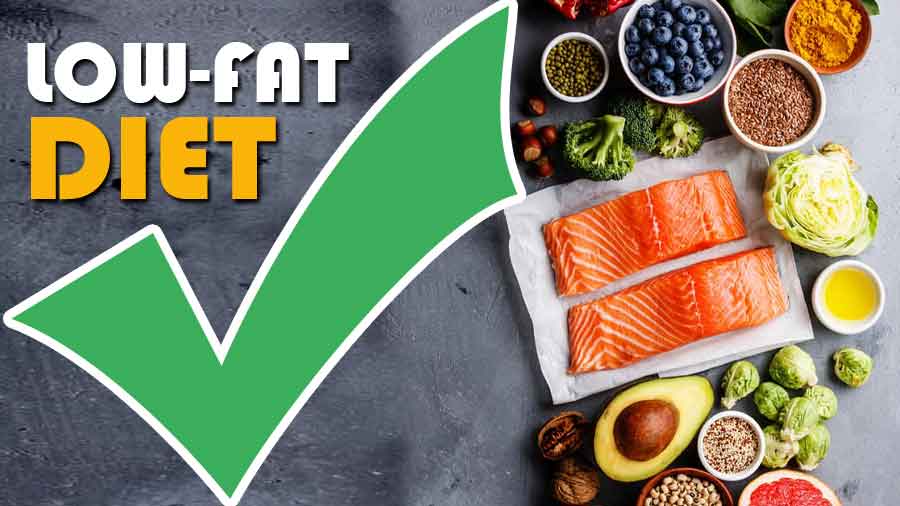So what should we do to keep our daily intake of fats within low fat diet guidelines? Here is a brief guide to the main food groups and their value in our diet and some alternative methods for preparing and cooking them.
Dairy Products
One of the main sources of saturated fats is dairy products; whole milk, butter, cream, cheese and ice cream. Where possible reduce your intake of all fat. However, polyunsaturated fats, contained in margarine or safflower, sunflower, olive and rapeseed oils although weight for weight containing the same fat and calorie content as butter, are a healthier source of fat than dairy products. Try to replace whole milk with semi-skimmed or skimmed milk. Cream substitutes, based on polyunsaturated fats and low-fat ice creams can all contribute to lowering our intake of saturated fats. Natural yogurt and low-fat hard cheeses, cottage and curd cheeses can also help.
Eggs
One large egg yolk contains almost a whole day’s recommended allowance of cholesterol, about 250-275 milligrams. It is a good idea to limit your intake of egg yolks to three a week. Egg whites contain no cholesterol and are a good source of protein. So, for example, if you are preparing scrambled eggs or omelets, it is better to use one yolk and several whites to increase the portion size whilst limiting the cholesterol and fat intake.
Beef, Lamb and Pork
Watching your fat intake does not mean giving up all meat. But take care. Limit your portions to about 75 g/3 oz, look for lean cuts and remove all visible fats before cooking. Try to mince very lean steak like sirloin yourself or ask your butcher to do so. When roasting meats, always place a rack in the bottom of the roasting tin so that the meat does not sit in its own juices, and try to roast for longer, but at a lower temperature, 350° F (180° C / Gas Mark 4), so that meat is not seared, thus sealing in the fat. If you are grilling meat, try adding flavor by marinating it first in herbs, wine, tomato or lemon juice. Incidentally, if you casserole or stew meat it is a good idea to start the cooking off the day before. Chill the stew and skim off the solidified fat before completing the cooking time.
Sausages and Processed Meats
These product often have hidden fats so read the labels carefully and select those with no more than 10% fat by weight or three grams of fat per ounce.
Poultry and Game
These foods are often lower in fats than red meat but do be careful to choose lean varieties. Chicken and turkey are leaner than goose and duck for example. Most of the fat in poultry is just beneath the skin so remove the skin and trim away all visible fat before cooking.
Poaching, sautéing, grilling and stir-frying are all good methods for cooking poultry and meat, needing little oil, provided they are cooked at high temperatures and kept moving in the wok or pan. Microwaving is also an excellent way to cook without adding extra fat. Indeed you can drain food of extra fat by placing it between two sheets of kitchen paper while it is cooking.
Fish and Shellfish
Fish is often recommended as a good source of protein and is generally lower in cholesterol than red meat. Steaming or poaching and once again microwaving are all good methods of cooking fresh fish. Cooking whole fish in paper or foil parcels with herbs and flavorings seals in the flavor without the need to add extra fat during cooking (see above). Shellfish: prawns, lobster, crab, and other shellfish are very low in fat although weight for weight some types of shellfish contain more cholesterol than meat and poultry. However, even these can be eaten occasionally.
Fruits, Vegetables, Grains and Legumes
These foods have no cholesterol and tend to be low in fat and often high in fiber and vitamins. Olives and avocados are high in fat but since the fat is largely unsaturated they need to be avoided only for their high calorie count. Be careful, however, to check the labels of processed foods made from vegetables, grains or legumes for fats added during processing. Breads and pastas made with egg yolks should be avoided. Also check that processed vegetables have not had sodium added. Ideally, fresh produce is always a better choice.
Cakes, Pastries, Crackers and Crispbreads
Cakes and pastries tend to be high in calories and fat and not of any great food value. If you are baking at home, try to substitute oil for fat and egg whites for yolks. Read the labels on packets of crackers and crispbreads before buying as they are often coated in vegetable oil before crisping, and may be higher in fat than you imagine.
In general, as a rule of thumb, whatever your daily calorie intake, the recommended proportions of nutrients are as follows:
| NUTRIENT | RECOMMENDED INTAKE |
| Total fat | 35% of total energy (kcal) (e.g. in a 2000 calorie diet not more than 700 calories should come from fat. This equals 80 g fat per day, or 40 g fat for every 1000 calories). |
| Saturated fatty acids | Less than 10% of total calorie intake |
| Polyunsaturated fatty acids | Upto 10% of total calorie intake |
| Monounsaturated fatty acids | 10-15% of total calorie intake |
| Carbohydrate | 50% of total calorie intake |
| Protein | 10-20% of total calorie intake |
| Total Calories | To achieve and maintain desirable weight |

